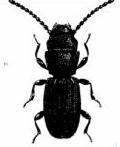Safeguarding Harvests: Effective Pest Control in Storage Silos
Pest Control
 Pest control is a critical aspect of agriculture and public health, aiming to manage and mitigate the adverse effects of unwanted organisms on crops, livestock, and human environments. Pests, encompassing insects, rodents, fungi, and other detrimental species, pose significant threats to food production, causing yield losses and quality deterioration. Employing effective pest control measures is essential to ensure a secure and abundant food supply.
Pest control is a critical aspect of agriculture and public health, aiming to manage and mitigate the adverse effects of unwanted organisms on crops, livestock, and human environments. Pests, encompassing insects, rodents, fungi, and other detrimental species, pose significant threats to food production, causing yield losses and quality deterioration. Employing effective pest control measures is essential to ensure a secure and abundant food supply.
Integrated Pest Management (IPM) is a holistic approach that combines biological, cultural, physical, and chemical control methods. This strategy emphasizes sustainable practices, minimizing reliance on chemical interventions and promoting natural mechanisms for pest suppression. Regular monitoring and early detection are key components of IPM, enabling swift responses to potential infestations.
Chemical control involves the use of pesticides to manage pest populations. While effective, it requires careful consideration of environmental impact, human health risks, and the development of pesticide-resistant strains. Organic and biological control methods, such as introducing natural predators or using biopesticides, offer eco-friendly alternatives, aligning with the growing demand for sustainable agriculture.
Ultimately, successful pest control strategies involve a balanced and adaptable approach that considers ecological, economic, and social factors. By integrating various methods and staying informed about emerging technologies, agriculture and public health sectors can address pest challenges while minimizing the impact on ecosystems and human well-being.
Storage silos are integral to preserving harvested grains, but the threat of pest infestations poses a constant challenge. Implementing robust pest control measures is paramount to ensuring the longevity and quality of stored grains. In this article, we will explore the significance of pest control in storage silos and delve into methods that farmers and storage facility operators can employ to safeguard their agricultural yields.
The Pervasive Threat of Pests
1. Types of Pests: Insects, mites, rodents, and fungi are common pests that can jeopardize stored grains, leading to spoilage and quality degradation.
2. Impact on Quality: Pest infestations can result in nutritional loss, mold growth, and contamination, rendering stored grains unfit for consumption or commercial use.
Effective Pest Control Strategies
1. Regular Inspection: Routine inspections of stored grains are crucial for early detection of pest infestations. Visual checks and monitoring devices can help identify signs of pests promptly.
2. Proper Sanitation: Maintaining cleanliness in and around storage silos is a fundamental preventive measure. Removing spilled grains, debris, and residues deprives pests of food sources and breeding grounds.
3. Temperature and Moisture Control: Implementing temperature and moisture control measures can create unfavorable conditions for pests. Proper aeration and ventilation help regulate the environment within the silo.
4. Sealing Entry Points: Ensuring that silos are tightly sealed prevents pests from entering. Gaps, cracks, and openings should be sealed to fortify the silo against external infestations.
5. Natural Predators: Introducing natural predators of pests, such as certain beneficial insects, can be an eco-friendly approach to controlling infestations.
Chemical Control Methods
1. Insecticides and Fumigants: Application of approved insecticides and fumigants is a common practice to eliminate and prevent pest infestations. However, careful consideration of safety measures and adherence to regulations are imperative.
2. Residual Treatments: Treating the interior surfaces of silos with residual insecticides can provide long-term protection, creating a barrier against pests.
Safety and Environmental Considerations
1. Protective Gear: Those involved in pest control activities should wear appropriate protective gear to minimize exposure to chemicals and ensure personal safety.
2. Environmental Impact: Choosing environmentally friendly pest control methods and complying with regulations mitigate the environmental impact of chemical treatments.
Conclusion
Effectively managing pest control in storage silos is vital for safeguarding the quality and quantity of harvested grains. Combining preventive measures, regular inspections, and judicious use of chemical controls can contribute to a resilient and sustainable approach in securing agricultural yields, supporting food security, and maintaining the integrity of the global food supply chain.

